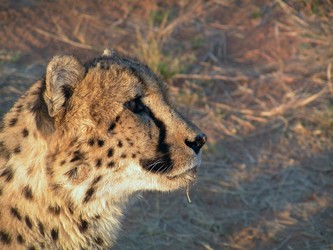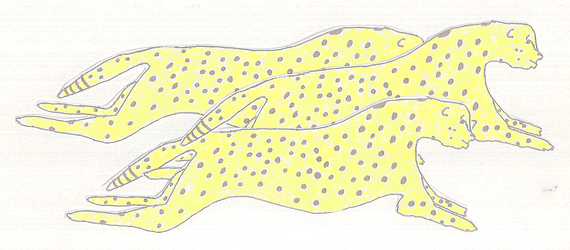Rules:
The Namibia Derby takes cheetahs from all over the world and faces them off in a competitive tournament to determine the fittest. The competition is composed of comparing the combination of individual time trial heats of each cheetah. Each cheetah will be timed as it attempts to hunt down a variety of prey (i.e. hares, antelopes, wildebeest and zebra). The idea is to create ideal hunting conditions for the cheetah within the limits of what is probable in nature. The prey will be put in a herd (the size of how, approximately, it would be found in nature) in the middle of the race grounds (about 4 square km). A cheetah will be entered into the hunting grounds when the time begins and the cheetah will be given 3 hours to hunt down its prey. The time stops when the cheetah has successfully stalked, captured and killed its prey. Each cheetah will have to hunt each species of prey individually. The final results will be the combined times of all the four heats.


Acinonyx jubatus portrait. © 2004 yaaaay
Track Description:
About 50 km north of the Etosha Pan, in Namibia, lies the Angolan Mopane woodlands and our venue for the 2009 Namibia Derby where our cheetahs will be facing off, in these subtropical savannahs. The track is covered with medium to tall grass growing up 3 metres, the grass is decently long this year allowing for greater camouflage for the cheetahs. There are a few scattered short trees, mostly acacia and baobab, allowing for minimal obstruction. The land is mostly flat and will most probably be dry as there is only about 300-600 mm of rain a year; dry soil will ensure that cheetahs have maximum mobility during the heats.
Different Prey:
Blue Wildebeest: Slowest of the chased prey, but it is the heaviest, weighing up to 380 kg, and most capable of defending themselves, considering their weight with their outward extending horns. The cheetah that is most capable of identifying the weakest of the herd and isolating it will be the most successful against the wildebeest. The cheetahs’ strength will also be a major factor in the results of this heat.
African Savannah Hare: Very small and hard to detect, the cheetah with the best vision and tracking ability will have success against the hare. Once the hare is spotted, this animal is extremely agile and though most cheetahs can easily outrun the hare in a straight race (as the hare can rarely top 72 km/h), it is the hares ability to change direction that will be most challenging for the cheetahs. Therefore agility is another quintessential asset for the cheetah to possess in this heat.
Plains Zebra: A decently fast horse-like animal with a decent amount of weight is not much of a physical match to the cheetah, nor is it hard to find with its obvious stripes which stick out in the savannah grasslands. The zebra’s pièce de résistance is its ability to detect a predator from a distance, as it has amazing eyesight (eyes on the side of its head give it a greater range of vision) and a very acute sense of hearing. The cheetah who can most successfully camouflage itself and stalk quietly will have the best time during this heat.
Springbok Antelope: Being a lighter creature with a decent ability to detect predators, this animal relies mainly on its speed as protection. This will be almost a simple footrace, though camouflage will help close the distance before the chase is initiated. The springbok antelope also blends decently with the savannah grassland environment and so a certain amount of tracking ability and vision will also be necessary.


Multiple cheetahs running side by side. © Jakob Fitzgerald
Different Cheetah:
| Name | Native Habitat | General Analysis (Betting Guide) | Betting Odds |
|---|---|---|---|
| The Pink Panther | Angolan Mopane Woodlands, Namibia/Angola | Being from the Angolan Mopane Woodlands, this cheetah will have a home-grounds advantage as he is familiar with the grounds and the prey he will be hunting. This will prove to be advantageous for the tracking portion of each heat. The Pink Panter is known for his speed which will give him an edge against the faster prey and makes him the favourite to win this derby. | 2:3 |
| Cream n’ Spice | Kalahari Acacia-Baikiaea woodlands, Botswana | The current leader in the overall circuit, Cream n’ Spice, has very good odds of winning. Being from the Kalahari Acacia-Baikiaea, a very similar habitat to these grounds, this cheetah will be familiar with the prey and have a relatively good sense of the grounds themselves. This cheetah has the King Cheetah genetic mutation, giving Cream n’ Spice a thicker, darker coat in which his spots are larger and almost connected. This provides better camouflage in the tall grass than a regular coat. | 3:5 |
| Talabacheetah | Tehran Desert, Iran | The biggest risk of all the cheetahs, this cheetah will have to quickly adapt to foreign land, prey and climate to have any success. This cheetah’s lack of experience in this type of habitat, and the marked difference between its native habitat and the Namibian hunting grounds will give this cheetah a serious disadvantage. Though in his favour, this cheetah is used to harsh conditions in Iran from lack of water to snow and if the conditions are bad, Talabacheetah will have an easier time adjusting than the other cheetahs. | 1:50 |
| Wet Socks | Western Saharah | A newcomer to the circuit, this will be Wet Socks 3rd derby, and up to this point he has shown impressive results, placing 2nd and 3rd in the Saharan and Yazdi Derby respectively in the circuit. This cheetah's main advantages are his ability to deal with limited resources such as lack of water, as he can thrive on the blood of his prey, and his surprising strength. This strength will give him the advantage against the heavier prey, and for Wet Socks to have a chance to win he will have to excel against the Blue Wildebeest, which in the past the other cheetahs have struggled against. | 1:15 |
Information on the Internet
- Cheetah BBC.com. Accessed 10 Sept. 2008
- Cheetah C., Carolyn. Accessed 14 Sept. 2008
- Facts About the Cheetah Natural-Track.com. 2001. Accessed 14 Sept. 2008
- CheetahSpot.com Marin, Cheech. Accessed 14 Sept. 2008.
- Cheetah, Fast, Agile Wild Cat ... Underdog Of The African Plains Roocroft, Gareth. South African Game Reserves. Accessed 12 Sept. 2008



 Go to quick links
Go to quick search
Go to navigation for this section of the ToL site
Go to detailed links for the ToL site
Go to quick links
Go to quick search
Go to navigation for this section of the ToL site
Go to detailed links for the ToL site